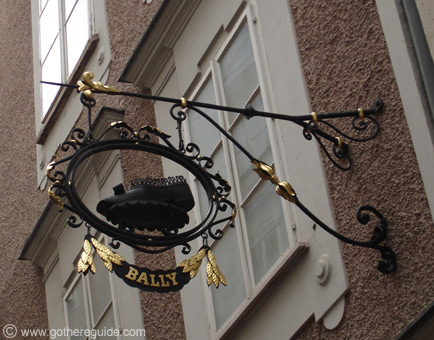
Getreidegasse - Getreidegasse information and pictures
| Tweet |
The shopping lane was a major Roman road at a time when the city was known as Iuvavum. Under the rule of Archbishop Wolf Dietrich von Raitenau, the street was a main road leading to Bavaria. Rich merchants, doctors, and craftsmen lived in the neighborhood, making it one of the best in Salzburg.
The rows of buildings along Getreidegasse and Judengasse grew from a former merchant quarter found on the Waagplatz or Weighing Square. Property borders prevented further expansion to the west and south while Salzach River and the city walls prevented expansion to the north.
Tightly nestled together, the houses have beautiful portals and small windows on the upper level. The buildings appear narrow, but they extend to the back and are not small. In the past, the space behind the buildings was mostly used for gardens. It gradually gave way to stables, storage buildings, workshops, and apartments for the servants. The court yards developed when the main and rear buildings got connected. The rear buildings were later turned into shops with a larger shopping area. The passageways transformed into covered galleries and shopping passages.
Salzburg’s charm and architectural flair is in part due to these interconnected buildings and courtyards. The courtyards are impressive by themselves. Typical elements include chapiters, vaulted passageways, columns, reliefs, moulded cornices, and marble balustrades. Dates and names are engraved on the buildings. Visitors can even see the names of previous owners and the dates the buildings were constructed. Looking closely, tourists will notice interesting guild signs, which served as advertising signs, telling shoppers what was sold in the shops. The unique architecture is complemented by colored flower arrangements and narrow, steep steps. Most courtyards are covered with arcades and are must-see when visiting Salzburg.
Madonna with the Child is depicted on a relief in a dark niche. A house where Mozart lived is a major attraction, which is found on Getreidegasse 9. Today, it works as a museum which is open daily.
The busiest passageway is Schatz Haus which leads to the University Square. The shopping lane itself is populated with boutiques, specialist shops, coffee shops, and restaurants. The shops are located next to take-away venues, traditional inns, and little restaurants. In the shops, visitors will find fashionable clothing, antiques, jewelry, perfumes, the national costume ‘Tracht’, and much more. ‘Sound of music’ memorabilia and Mozart souvenirs are bought by many tourists. Finally, although Getreidegasse is a busy shopping lane, it should be noted that many flats and houses there are occupied by students and middle class families.


Getreidegasse iron sign
Where is Getreidegasse: Getreidegasse, Old town Salzburg
Please help us build a better site. Add your comments about Getreidegasse here.

Salzburg Attractions
Copyright © GoThereGuide.com 2015
All rights reserved.
All rights reserved.
User Comments about Getreidegasse